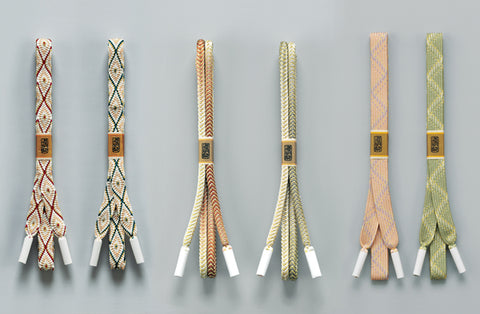 From the Meiji era (1868-1912) on through the Taisho era (1912-1926), as most producers of the braided cords known as kumihimo were mechanizing their production process, the 6th generation owner of our establishment, Domyo Shinbei, doggedly protected the hand-done work of master craftsmen. Thanks to these efforts, all of our products remain hand-dyed, and hand-braided to this day.
From the Meiji era (1868-1912) on through the Taisho era (1912-1926), as most producers of the braided cords known as kumihimo were mechanizing their production process, the 6th generation owner of our establishment, Domyo Shinbei, doggedly protected the hand-done work of master craftsmen. Thanks to these efforts, all of our products remain hand-dyed, and hand-braided to this day.
Braiding
Around the world, there are three major methods of textile production; weaving, knitting and braiding. Each one has an intrinsically different structure. Braiding is done by diagonally overlapping a set of threads that are tied off at one end in a zigzag pattern creating an ever-lengthening cord. The cord that is created through this process is called kumihimo in Japanese. The way the threads overlap is what gives our kumihimo their beauty.

The Way of Braiding
The work is all about endless repetition. With constant rhythm and hand movements from beginning to end, a homogenous cord is produced. On rainy days, on windy days, on good days, and on bad days, no matter what, you must continue braiding every day. Idle thoughts can have a significant effect on the outcome. It’s of particular importance to empty your mind and focus on the present moment.

On Hand Dyeing
Dyeing the yarn is the first step in making kumihimo. Every single strand of thread we use is lovingly dyed one color at a time by Domyo’s craftsmen.
This allows us to choose from a rainbow of different color combinations for our braided creations. It’s also impotent to our monochrome kumihimo, allowing them to give a distinct impression of the depth of expression that can found in a single color.
With multicolored braids color coordination is vital, as subtle differences in the hue and saturation of each color can greatly affect the overall impression. Yarn dyed beautifully, and in a suitable color, is the first step in making kumihimo.




On Hand Braiding
Hand braided kumihimo have an elasticity and texture not found in those produced by a machine. That is to say that – thanks to the personal experience of the skilled craftsman – there is a hands-on awareness of the application of power, the degree of strength needed. Subtle hand movements that have become second nature help create the final product. Cords braided with the unwavering consistency of a machine don’t even come close to matching the complexity and delicacy of a handcrafted braid. You can truly feel the personality of the individual craftsman in each one. Even when made with the same braiding style and the same type of thread, no two are ever exactly alike.

True Beauty
There are hundreds of different ways to braid kumihimo, but broadly they can be classified in the wide and flat hiragumi style, or the rounded, thicker cross-section of the kadogumi style. Moreover, even within the same braiding method, the delicacy of the final product can be completely different depending on the temochi (or the number of threads attached to a single bobbin), as well as the number and size of the bobbins. By increasing the temochi and reducing the number of bobbins you can braid more quickly, but you’ll end up with a larger and rougher cord.
Additionally, the number of different colors and their hues, as well as the garaoki (or the order in which the threads are arranged), can change the design in a number of ways. We take great pains to determine the optimal combinations and arrangements from among the countless colors available.







